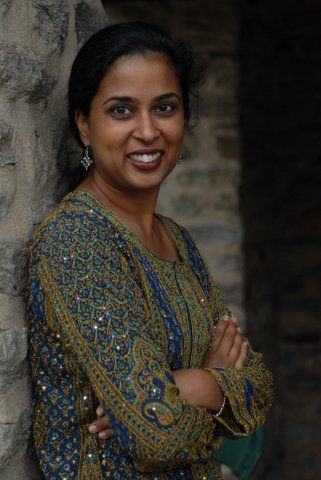On intersectionality and toxic body culture
This guest post comes from Sayantani DasGupta, an incredible woman working at more intersections than most of us wrap our minds around in a given day. A short bio can be found after the jump. Is toxic body culture a white women’s issue? (The answer is no, but read on…)
Is toxic body culture a white women’s issue? (The answer is no, but read on…)I recently was invited to attend the Endangered Species Summit in New York, one in an international series of summits organized by Courtney Martin, The Women’s Therapy Center, and others. Although I knew I was to speak with a powerhouse panel of women on globalization and medicalization, and I also knew Courtney’s commitment to diversity and a feminist intersectionality (thinking about gender oppression in the context of race, class, sexuality, etc., see here), my first thought on entering the room was “this issue isn’t relevant to me.” It was a strange, visceral reaction that wasn’t about who was present in the room, but how (I assumed) the argument was being framed.
My feelings of alienation took only a few minutes to dissipate – when Jean Kilbourne made clear that media representation of women’s bodies couldn’t be understood without understanding the mechanics of capitalism and consumption; when comedian and performer of the one-woman show “Fat Bitch” Erica Watson said that her grandmothers’ generation was unable to worry about how people saw the size of their bodies because “they were too busy trying to keep their men from getting lynched.” But until I heard people on stage make those broader connections explicitly, I felt shut out of the discussion and the summit’s agenda. Why is that?
As a little brown girl growing up in the heart of the Midwest, the ‘toxic body culture’ I lived in was not only to do with my gender, but firmly with my race/ethnicity. I believed I was unattractive not because I was a girl and couldn’t live up to the images of beauty around me, I believed I was ugly because I was a brown girl and couldn’t live up to the beauty standards around me.
The very first essay I ever sold was called Glass Shawls and Long Hair: A South Asian Woman Talks Sexual Politics, and it appeared in the March/April 1993 issue of Ms. Magazine. In it, I wrote:
As a child, I believed my self to be intolerably ugly. I know now I was not the only little brown girl to be ashamed of her skin color, her name, her difference. I was not the only person asked if she rode elephants, or slept in a tepee, or ate snakes. Mine was not the only skin to be rubbed by little white hands to see if the ‘tan’ would come off. The insidious victimization robbed us of the power to identify it as racism.
Similarly damaging, I wrote, was any false sense of exotic beauty, a self-Orientalization of ankle bells, glass shawls and long hair.
It’s ironic, in fact, that I felt initially alienated from a summit on embodiment politics when that is the very heart of my life’s work. Originally trained in pediatrics and public health, my writing, teaching, and thinking now occur at the intersection of narrative, health and social justice. I am committed to issues of representation and embodiment vis a vis. gender, race, reproduction, illness, disability, queer and transgender experiences, etc. In fact, when I heard the name of the summit, I actually thought it referred to the “100 million missing girls and women” around the world (see essay by Nobel Laureate Amartya Sen) – the global demographic gender imbalance resulting from female fetocide (the practice of aborting female fetuses after amniocentesis or preimplantation genetic diagnoses), nutritional and other forms of daughter disfavor, and violence against girls and women.
To me, I cannot think of my own embodiment any more without thinking of my body in the context of these broader social forces, and in alliance with these other, global bodies. While, as a mother of a six year old girl, I cringe at pink princess culture, Abercrombie and Fitch’s new, padded bikini tops for little girls, or reports of eight year olds getting botox injections, I also feel committed to understanding these phenomenon operating around my daughter (and my 8 year old son) in the context of globalization, capitalism, racism, gender oppression, heteronormativity and the like, while recognizing my own potential role in the perpetuation of these inequalities.
So no, toxic body culture isn’t a white woman’s issue. It’s not even a woman’s issue–it’s all our concern. But only if a discussion of advertising happens within an understanding of consumerism, if beauty standards are discussed alongside able-ism or the oppressions of gender and sexuality binaries, if local embodiment politics is contextualized within broader global forces.
As I wrote in that long ago essay on beauty politics: “Our beauty must come from a critical understanding of the forces at work around us… it must rise from within our individual and among our collective selves.”
Sayantani DasGupta is a physican and writer, originally trained in pediatrics and public health, currently a faculty member in the master’s program in narrative medicine at Columbia University and the graduate program in Health Advocacy at Sarah Lawrence College. She teaches courses on illness and disability memoir, and narrative, health and social justice. Sayantani’s scholarly work in the field of feminist health science studies, most recently looking at transnational surrogacy, what’s been called the Indian ‘wombs for rent’ phenomenon. She is a widely published and nationally recognized speaker on issues of narrative, health care, race, gender and medical education. She is the co-author of The Demon Slayers and Other Stories: Bengali Folktales, the author of a memoir about her education at Johns Hopkins, and the co-editor of an award winning collection of women’s illness narratives Stories of Illness and Healing: Women Write their Bodies.